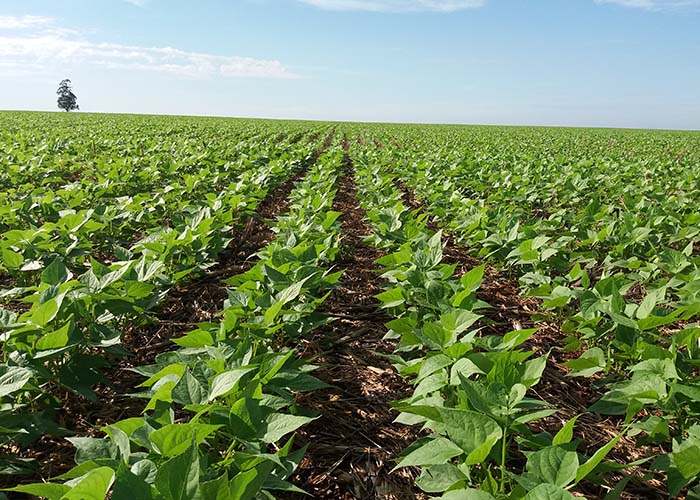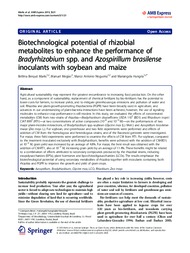Combination of microorganisms can increase bean productivity in up to 11%
Combination of microorganisms can increase bean productivity in up to 11%
Embrapa researchers have proved that when common beans are coinoculated with Rhizobium tropici and Azospirillum brasiliense, they can reach 11% greater productivity levels than when with nitrogen fertilization, and average production above 3,200 kilos per hectare (ha).
According to the researcher Enderson Ferreira, from Embrapa Rice and Beans, who coordinates the research on coinoculation, the new technique brings economic advantages to farmers and to the environment through the use of urea, and it has the potential to fully replace nitrogen (N) applications when combined with the two microorganisms.
The researcher considers that the joint performance of Rhizobium tropici and Azospirillum brasiliense is a viable solution towards higher yields. Azospirillum works by potencializing plant development (especially roots), resulting in better conditions to establish symbiosis with Rhizobium in nitrogen fixation. On top of such association, the larger root volume generated by Azospirillum improves the absorption of soil water and nutrients, increasing the growth of the plant's aerial parts and grain production.
Researcher talks about the coinoculation project
Profits of up to 114% in Minas Gerais
According to the economic analysis conducted by Embrapa Rice and Beans' socioeconomics researcher Alcido Elenor Wander and analyst Osmira Silva, the smallholders who adopted coinoculation had a 13% profit. That is, each R$ 1,000 invested in the crop returned the amount of R$ 1,130 to family farmers. In corporate agriculture, the income was even higher: 90% in the Brazilian state of Goiás and 114% in Minas Gerais state. Translating that into currency, farmers in Goiás had returns of R$ 1,900 for every R$ 1,000 they employed, while the return in Minas Gerais was of R$ 2,140 for the same investment.
The environment also benefits from the non-application of chemical fertilizers in the farms, the researcher emphasizes. Among the grain crops, a category which includes beans, it is expected that the increase in the area cultivated with the use of Biological Nitrogen Fixation will be responsible for a good portion of the Brazilian government's environmental targets: curbing greenhouse gas (GHG) emissions by between 36.1% and 38.9% by 2020.
Bean coinoculation would remove 700,000t CO2 from the atmosphere
Ferreira mentions Embrapa studies demonstrating that if the use of nitrogen fertilization was replaced by coinoculation in the total bean cultivation area in Brazil, there could be a mitigation of approximately 700,000 tons of CO2, which would contribute to achieving 52% of the goal established by the Brazilian government.
According to estimates from the National Association for the Diffusion of Fertilizers (Anda), Brazil annually uses 25 Kg/ha of the product. As the average planted area in the country is about three million hectares, that entails 75,000 annual tons of nitrogen. Considering the adoption of urea, whose ton costs around R$1,200.00, and that it takes 167,000 tons to reach such estimate of nitrogen application, the final annual cost for Brazilian farmers surpasses R$ 210 million.
Deemed a staple among Brazilians, beans are one of main foods and main source of plant protein for millions of consumers from low income families, contributing to about 28% of all protein ingested by the population. This is shown in a study by the researcher Mariângela Hungria, from Embrapa Soybeans, an important specialist in BNF in Brazil. According to data from the researcher Alcido Wander, the average production of bean croplands in Brazil is 1,068 kg/ha.
What is an inoculant?An inoculant is a product that contains microorganisms that benefit plant development. In the case of Rhizobium, the application is made on the seed, before sowing. It is accessible to any farmer in farming supplies stores. Meanwhile the application of Azospirillum is made through spraying, at specific moments of the crop's development. In technical terms, it would be when the plant is at the phenologic stagez V2 (primary leaves, open pair of primary leaves) and V3 (first trifoliate leaf, with open leaflets). |
The importance of nitrogen
Nitrogen is one of the elements that are present in the highest concentrations in plants and one of the main nutrients for plant development. It performs essential roles, contributes to increasing the quality and productivity of the grains, is essential for photosyntheses, and is directly related to the formation and increase of protein content in the grains. In the case of common bean plants, besides promoting greater growth, nitrogen influences some components that are key to the success of production, such as higher number of pods in the plants and heavier grains.
Rhizobium and Azospirillum are known in the agricultural sector for their nitrogen fixation capacity - the former in bean plants, the latter in rice, maize and wheat crops -, and both are already used by growers. For beans, however, Azospirillum presents a distinct performance from what happens in the other crops, promoting plant growth through hormone production, mainly acid insoluble ash (AIA).
Current research with coinoculation is exploring new microorganisms and presenting other mechanisms that help in plant development, productivity increases, disease control and nutrient solubilisation.
Translation: Mariana Medeiros
Henrique de Oliveira (MTb 1.960/GO)
Embrapa Rice and Beans
Press inquiries
arroz-e-feijao.imprensa@embrapa.br
Phone number: +55 62 3533-2108
Further information on the topic
Citizen Attention Service (SAC)
www.embrapa.br/contact-us/sac/


